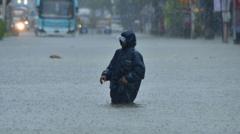Heavy downpours have turned India's bustling financial hub, Mumbai, into a submerged landscape, with knee-deep water blocking roads and halting public transport. The relentless rainfall has led to the cancellation of numerous flights and significant delays in train services. Dramatic footage has emerged of residents navigating through waterlogged streets, desperately swimming as debris washed out from clogged drainage systems.
On Tuesday, emergency services undertook the challenging task of rescuing around 600 passengers stranded on an overcrowded monorail that became stuck mid-journey. Civic officials reported that 23 individuals required medical attention for suffocation. Many schools and colleges across the city remain closed, while approximately 350 individuals from vulnerable low-lying areas have been relocated to temporary shelters.
Authorities have issued a red alert, anticipating further storms on Wednesday, although they are optimistic that conditions will start to improve later in the week. The India Meteorological Department noted that Mumbai has received a staggering 800mm of rain over the last four days—significantly surpassing the city’s average rainfall for August—resulting in over 21 fatalities in rain-related incidents across the state.
Local trains, a vital transportation link for millions, were severely affected, causing chaos at various platforms where thousands of commuters were left stranded for hours. Compounding the situation further, flight services to and from Chhatrapati Shivaji Maharaj International Airport saw a cancellation of roughly 50 flights in the past few days. IndiGo, a prominent budget airline, warned travelers of possible delays owing to the worsening weather conditions.
Amid the ongoing struggles, chaos unfolded after the monorail reportedly halted due to severe overcrowding, necessitating the intervention of rescue teams who used cranes to extract trapped passengers. A preliminary investigation indicated that the situation stemmed from trains being operated beyond their capacity.
Government criticism has ramped up, with opposition leaders, including Aaditya Thackeray of the Shiv Sena (UBT) party, accusing officials of a lack of preparedness despite the issuance of red alerts. They pointed out an observable failure in managing the crisis, especially noting the flooding affecting the city’s airport and the emergence of new waterlogged areas near newly constructed infrastructure.
Social media has buzzed with citizens expressing frustrations over deteriorating infrastructural capabilities and inadequate urban planning. Mumbai’s population, exceeding 12 million, continues to swell yearly with migrants in search of job opportunities, yet experts emphasize that the city's aging drainage systems and investment in climate-resilient infrastructure have failed to keep up with this growth.
As the city endures the brunt of the rains, the focus shifts toward effective responses and future strategies to mitigate similar crises.





















